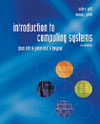
|  |
PowerPoints—NC StateAt NC State University, Introduction to Computer Organization (ECE 206) is required for both Electrical Engineering and Computer Engineering majors. It is typically taken during the first semester of the sophomore year. The freshman year curriculum is common across all engineering disciplines, and most students have had some exposure to high-level languages (usually Java or C++).
The "bits to C" approach exposes our students to a vertical slice of the many layers of a computer system. Our primary objective is to develop a broad understanding of the technologies and design issues, in order to provide a strong background and motivation for later courses in logic design, system design, computer architecture, and embedded systems.
We use most of the first half of the book, emphasizing digital logic, instruction set architecture, processor organization, assembly language, and interrupts. Because our students have already been exposed to Java, we do not cover much of the syntax-oriented chapters on C. Instead, we focus on the differences between C and other high-level languages, and the translation from C to LC-3 assembly language. Laboratory exercises reinforce the material from the book. Most exercises use the LC-3 simulator and assembly language, but we also address digital logic and C programming.
Contact: Dr. Greg Byrd gbyrd@eos.ncsu.edu Chapter 1
(259.0K) Chapter 1
(259.0K)
 Chapter 2
(398.0K) Chapter 2
(398.0K)
 Chapter 3
(1178.0K) Chapter 3
(1178.0K)
 Chapter 4
(1005.0K) Chapter 4
(1005.0K)
 Chapter 5
(906.0K) Chapter 5
(906.0K)
 Chapter 6
(750.0K) Chapter 6
(750.0K)
 Chapter 7
(276.0K) Chapter 7
(276.0K)
 Chapter 8
(298.0K) Chapter 8
(298.0K)
 Chapter 9
(932.0K) Chapter 9
(932.0K)
 Chapter 10
(486.0K) Chapter 10
(486.0K)
 Chapter 11
(226.0K) Chapter 11
(226.0K)
 Chapter 12
(164.0K) Chapter 12
(164.0K)
 Chapter 13
(259.0K) Chapter 13
(259.0K)
 Chapter 14
(143.0K) Chapter 14
(143.0K)
 Chapter 15
(250.0K) Chapter 15
(250.0K)
 Chapter 16
(143.0K) Chapter 16
(143.0K)
 Chapter 17
(128.0K) Chapter 17
(128.0K)
 Chapter 18
(103.0K) Chapter 18
(103.0K)
 Chapter 19
(124.0K) Chapter 19
(124.0K)
|
|
|